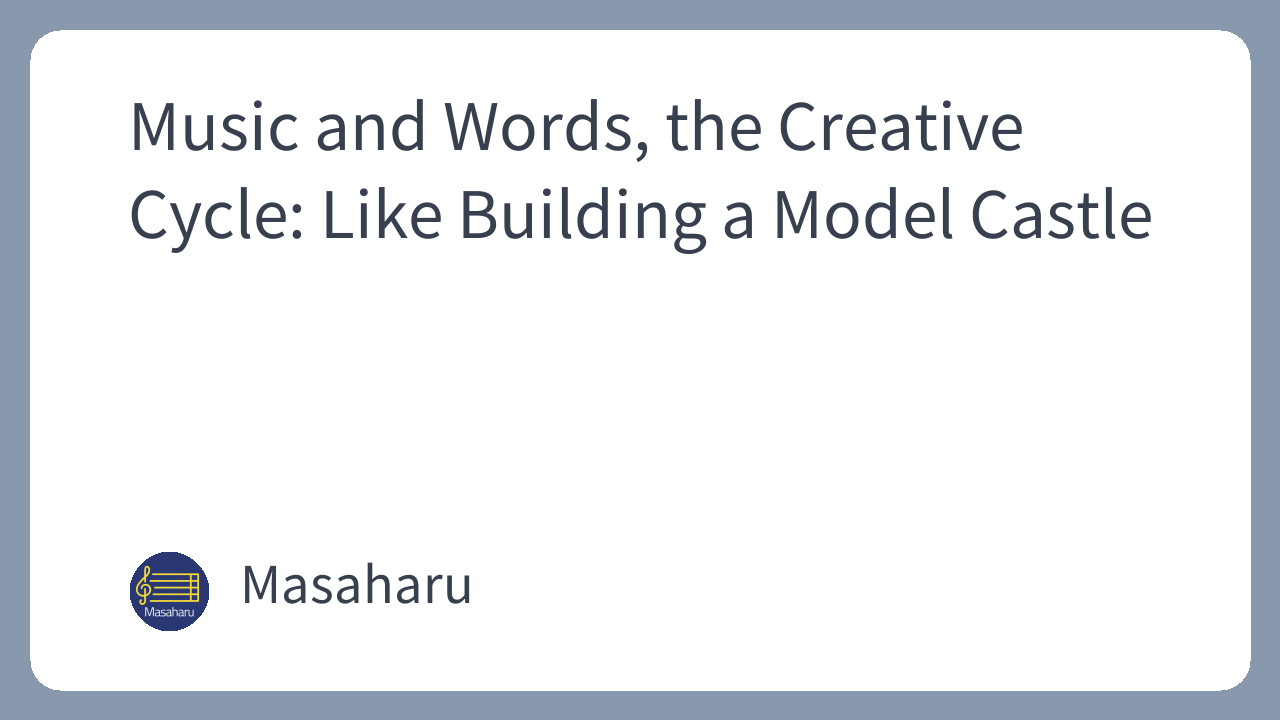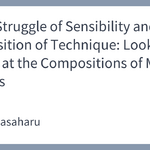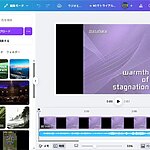When someone who creates music writes “about music,” what thoughts are going through their mind?
In my case, I understand the untranslatable, immense power I feel when standing before music—something that, in essence, cannot be put into words. It is precisely because I know this that I dare to weave words.
It is an act similar, perhaps, not to trying to grasp the dazzling light itself, but to meticulously tracing the contours of the shadow that light creates.
What is music? What is composition? By posing these questions and attempting to verbalize them, I am paradoxically forced to confront the point where I must acknowledge the inherently non-verbal nature of music itself. My “writings about music” might be described as sketches or abstractions drawn while standing on the precipice of the vast entity that is music.
Wittgenstein once said, “Whereof one cannot speak, thereof one must be silent.” However, as the art anthropologist Satoshi Nakajima suggests, perhaps while we must remain silent about that which we cannot speak, we *can* verbalize the “unspeakability of the unspeakable.”
To stand at the abyss of silence, to question why it is an abyss, and to speak. I believe this too is a sincere attitude for one involved in creation.
For me, the musical experience gained through composition is a unique one, making me realize the undeniable power and qualia (texture) of music. The words inspired by that experience take on the character of a secondary creation, so to speak.
The text born in this way is not merely subordinate to the music, nor is it a simple conversion of it. Rather, it is like a “satellite” caught in the gravity of the planet of music, yet drawing its own orbit—an independent creation in its own right.
Thus, this act of verbalization eventually establishes itself as one of my own creative acts. I listen closely to the music, gaze intently at it, and from there, I combine and assemble the words that emerge, constructing (composing) the text as a single object.
Composing music, writing text, and accumulating these creations under my own persona to form a singular *form*. This entire endeavor is, for me, filled with an excitement akin to building a “model of a castle,” symbolizing my creative activity as a whole.
I am fascinated by this meta-creative activity, where one can perceive and savor the aesthetics and attachments dwelling in the details of that form, the harmony and distortions of the whole, and the unique qualia evoked by that form.
Thinking further, this can be seen as constructing a “system for observing one’s own creative process” from the outside. In other words, by combining different modes of expression—music and words—it might become an “observational experimental apparatus” for enhancing one’s own creativity.
Inside this apparatus, there are two versions of myself. One is the “practitioner” who composes music. The other is the “observer” who watches the practitioner’s behavior from a meta-perspective, records it, and searches for the next creative direction and nourishment.
In doing so, one notices that this system begins to take on the appearance of a living organism. The biological concept of “autopoiesis” (self-production) might fit well here.
The practice of making music gives rise to questions demanding verbalization, such as “What did I create (what is this)?” Then, the observational act of “verbalizing” allows for self-objectification, leading to the supply of new perspectives and energy for creating the next piece of music.
Within me, music can guide words, and words can become the fertilizer that enriches the soil for music production. Through this cycle, the system continues to produce its own components, much like an autonomously driven life form.
And as the metaphor of a “life form” suggests, there exists a state of “health”—good or bad. Specifically, in my case, I usually feel an unhealthy sensation during periods when I am leaning too heavily on verbal activity as an observer.
This awareness of sensation is likely an alert to the situation where the practice (music production), which should be the fundamental energy of the system, is being neglected.
It is a warning signal that the creative energy is not circulating. It’s a discomfort, like a waste of not utilizing one’s creative potential, a sign that the system’s bloodstream is stagnating and its vitality is fading.
Above all, I wish to be someone who confronts music and gives it form, and I believe that is my way of delivering value. Therefore, when I fall into a situation where only words are exhausted without the accompanying practice, I feel a sense of emptiness. It’s a cliché, but I suppose I want to be a practitioner before I am a critic.
This feeling and these thoughts are, I believe, a crucial axis in my own creation. That is why, if a large gap emerges between what is produced and the words that are spoken, I might feel a kind of frustration or dissonance with myself.
At the same time, this gaze is constantly directed at myself. The question, “Is the ‘me’ who exhausts words drifting away from the ‘me’ who is a practitioner?” constantly acts as an inner otherness (a judge’s eye) that supports and admonishes me.
Of course, I believe everyone in the creative process stops, struggles, and sometimes wanders deep into the forest of words. That is by no means wasted time, and I feel that way when I reflect on my own experiences.
However, beyond that, rather than finding romance in being a “poet who doesn’t recite” or a “painter who doesn’t paint,” I hold the wish to place myself on the side of practice—of creating something, however small or clumsy it may be.
Thus, verbalizing my thoughts in this way is itself part of my creative system, and also a “health check mechanism” for this way of being. And even now, I feel the observer’s gaze watching me as I write this text.
What I have discussed here is likely something many creators have felt, but by verbalizing it in my own way, I feel my own state of being has become a little clearer.
The time spent thinking in the sea of words is important soil for my next creation and self-maintenance. But to keep the creative cycle from stagnating, I believe it is crucial to have an image of continuously stirring the whole, including that very process of thought.


